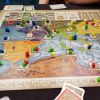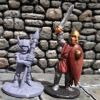- No items
-
Links
0
comments
Stick drawing adventurers with tons of in jokes and gamer tropes.
hairylarry
Jul 12 '20
relatedtogeeks
Jun 16 '20

















1. Take the TOP piece of an off-board stack (i.e. the largest) and place it on a blank space.
2. As #1, but place it over (any, regardless of colour) SMALLER piece already on the board.
3. Move any showing piece of that player's colour to a blank space on the board.
4. As #3, but place it over a smaller piece.
The goal is to get four in a row of your own colour: horizontally, vertically, or diagonally. If you touch any piece in play that you can play (on the board, not in your stacks), you *must* play it. If lifting up a piece reveals a line of four of the opposing colour, and your move doesn't stop that line of four from completing, you lose. (In other words there's a memory component to the game.)
It's fast (a long game is 15 minutes) and it's simple to learn. It may be a perfect "we've got a few spare minutes, let's play!" game.